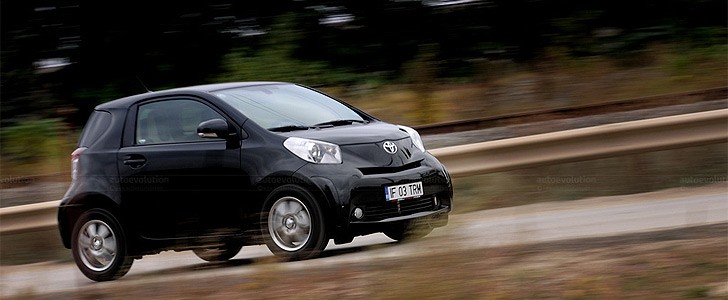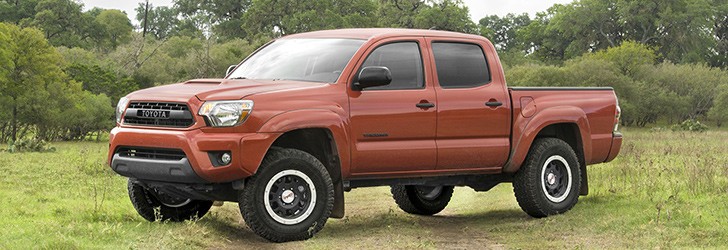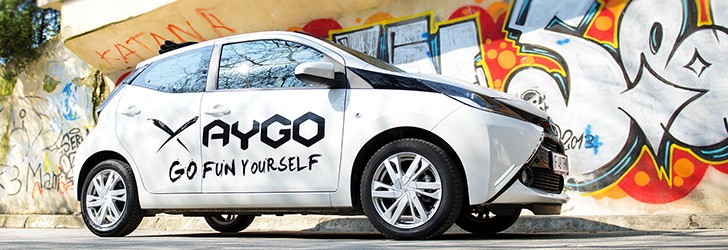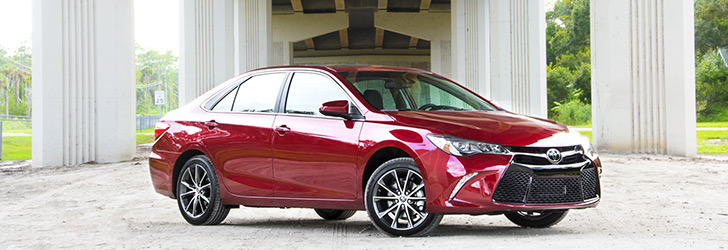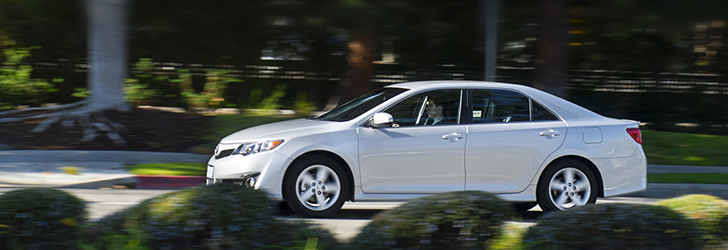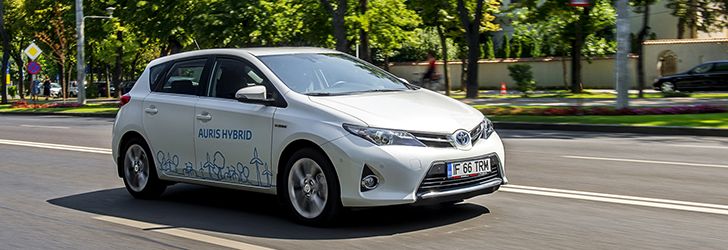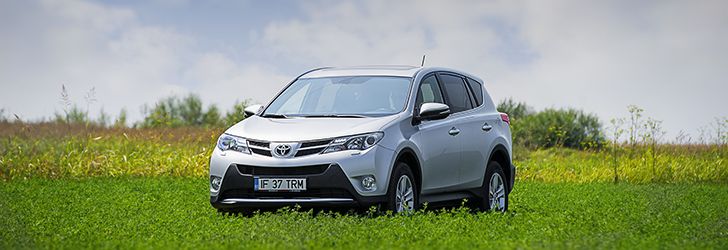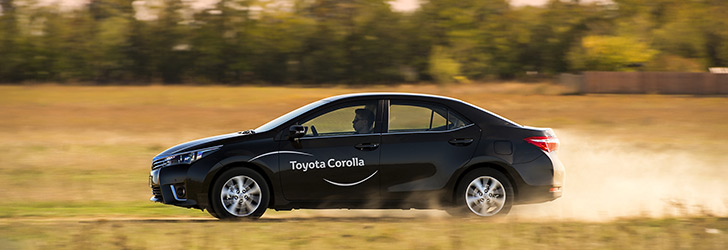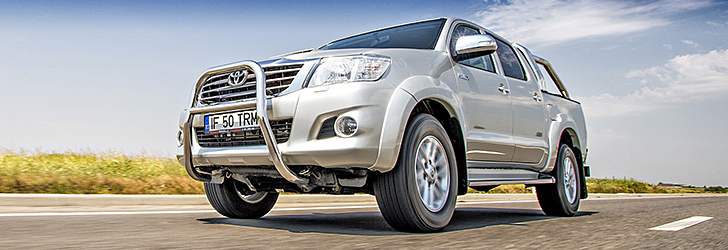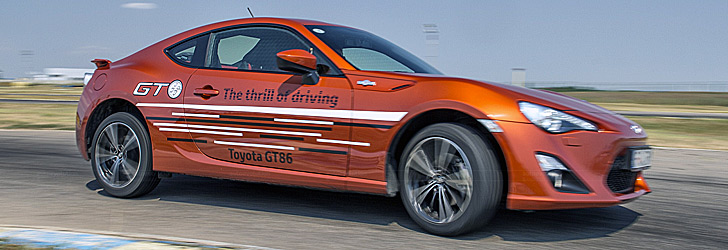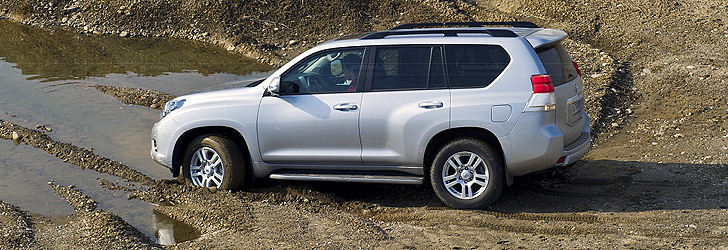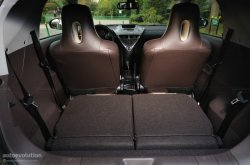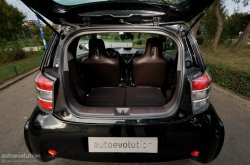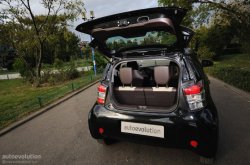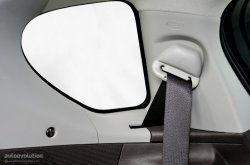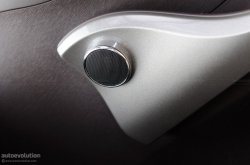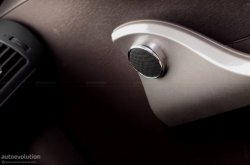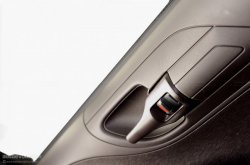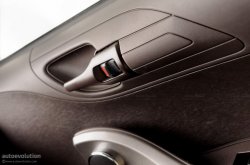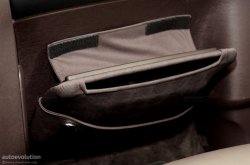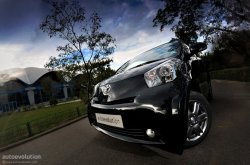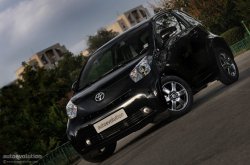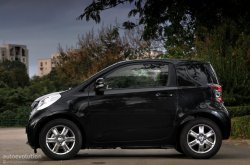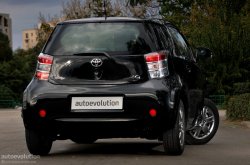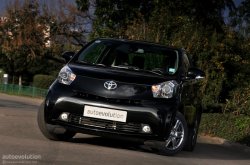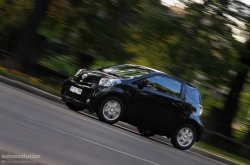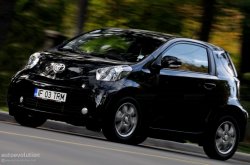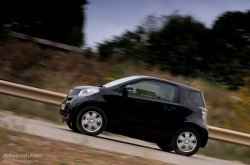TOYOTA iQ Review
OUR TEST CAR: TOYOTA iQ 1.0 MultiDrive
Continuing our comparo with the smart fortwo in the comfort area, we can honestly say that the Toyota iQ is quite a bit better from this point of view. Don't expect any Roll Royce-like wafting on poor roads, but the little bugger's suspension certainly doesn't shy away from soaking in a decent number of potholes or speed bumps. We would almost compare the iQ's capacity to do this to that of the Golf we tested earlier. Cool stuff!
Even so, you shouldn't trust it with too much from this point of view, the iQ is still smaller that just about everything on the road, except the aforementioned smart car. Sure, there aren't any sea-sickness-inducing motions whenever you're accelerating from a dead stop or hitting the brakes, but that is only partly thanks to the suspension setup.
Another reason for this gentle behavior towards the passengers' kidneys is the Continuous Variable Transmission, of course, which maintains the car completely jerk-free during acceleration and/or gear changes.
The interior space seems just right for a maximum of two persons sitting in the front. Any higher than that number of passengers will automatically mean (much) less comfort for everyone involved. In other words, two's OK, three's definitely a crowd.
As far as the interior comfort features, there were plenty in our test car. The seats were as comfy as in any "regular" Toyota, while the overall ambiance was that of a pretty well-made compact car. Though highly expensive for a car its size, you can totally see where the money has been spent. The great fit and finish and nice "thump!" sound when you close the doors contribute to a very solid overall feeling, while features like keyless entry, light and rain sensors and the funky automatic climate control system are there to provide you with quite a well being sensation.
The three-cylinder mill under our test car's short hood has a... let's say "decent" potential on tiny cars. For a gasoline engine it uses quite a small amount of fuel and, albeit it doesn't go like stink, it has sufficient performance. Of course, everything we just said about this engine is only true if it's not paired to a rubber-band CVT transmission in a Toyota iQ.
If that happens you can probably say goodbye to a great in-city fuel consumption and/or decent performance. You see, the very same engine is also used by the slightly larger Toyota Aygo/Citroen C1/Peugeot 107 trio and by the much bigger Toyota Yaris. On which of these cars would you guess that the engine behaves the best? If you guessed the petite iQ, you'd be dead wrong.
Strangely-enough in the iQ it feels as gutless as in the much larger Yaris, while the fuel economy is even worse when talking about driving in a crowded city. We suspect this happens for two reasons. First of all, though extremely small, the iQ is no featherweight automobile at 935 kilograms (2061 pounds). While it obviously doesn't actually sound very ponderous, it's almost as heavy as the much larger Yaris, and the class-leading drag coefficient of only 0.30 doesn't help it that much at city speeds.
Second of all, as we mentioned before, in our test car the engine was paired to a CVT, which is all fun and games when it comes to comfort but a total pain in the butt when talking about performance, be it acceleration or fuel economy. The CVT is an impressive piece of technology in theory, but in practice so far it has failed to deliver.
Contrary to what you would think by looking at such a lilliputian vehicle, the Toyota iQ is full of gadgets that you would otherwise expect to find in much larger but not necessarily much more expensive cars. As we said before, the iQ we tested is about as expensive as the Brabus version of the smart fortwo, which isn't exactly the least expensive micro car out there.
Apart from a very impressive array of safety features and the addition of two extra (unusable) seats, the Toyota iQ impresses with a list of gadgets not usually found in cars such as small. The first thing you will probably notice is the keyless entry and engine-start system.
This means that you will probably never have to take your key out of your pocket ever again. You just have to approach the car and the doors will self unlock. Once inside you only have to press the brake pedal and the start button on the dashboard and the three-cylinder mill in the front will suddenly spring to life.
Continuing on the "unlike any other car in its class" bandwagon, our tiny little test car was also equipped with electrically-powered side mirrors, light and rain sensors, two electrically-operated windows with an automatic feature, interior electrochromic rearview mirror, heated front seats and no less than three modes for the CVT.
Apart from the normal "Eco" mode in drive, the gearbox also had a completely pointless "Sport" mode and an odd "Winter" mode. Both "Sport" and "Winter" modes will probably never be used by average drivers, since the first one does almost nothing to improve performance while the second one would be better suited for an off-roader than for a city micro car.
When the second generation of the smart fortwo came along in 2008, the four stars it achieved at the EuroNCAP crash tests were pretty much the best any car this small had ever achieved. With the help of a very well-planned check list, Toyota engineers were able to make a car only slightly larger, but apparently quite a bit safer than that. Believe it or not, the Toyota iQ achieved no less than five stars at the aforementioned European crash testing authority.
How is this possible since the iQ is only about 30 centimeters (under 12 inches) longer than the fortwo and they both weigh about the same? Well, first of all, the Toyota iQ's engine is fitted in the front instead of being crammed under the luggage compartment. Second of all, it comes with the largest number of standard airbags in any car, ever.
There are the usual front dual-stage airbags, there are side airbags for the front passengers, head curtain airbags, a knee airbag for the driver, an anti-submersing airbag for the front passenger and last but not least, there's also a window-bag which should protect whoever fits in the back from rear impacts. That's a total of no less than nine (9!) airbags spread all around the tiny iQ's interior!
If you're still in doubt you should also learn that the iQ has a standard anti-lock braking system, emergency brake assist and an electronic stability control system (VDC). Frankly, with performance figures so low, we can't imagine why are all these active safety systems present but it's better to have them then not to.
Having tested its number one competitor, the second generation of the smart fortwo, we can provide a pretty clear conclusion about the best side of the Toyota iQ. Even though it loses by a hair in a number of chapters against the smart, it also wins by a notch in other areas as well. Strictly for city driving, even though it's slightly longer, the iQ seems to be a better weapon against congestion. It's more comfortable, better equipped and has a lower turning radius. It's also much, much safer.
The worst part about the Toyota iQ has to be the way it's being marketed, but it has other downsides as well. For example, Toyota marketing advertises it as a 3+1 vehicle, when in fact only small children or amputees can properly fit in the rear, meaning the luggage compartment remains strictly for fitting a couple of rolled newspapers. We've seen glove compartments with more volume than the iQ's trunk. Plus, with the money payed for a well-specced iQ you can buy yourself medium-equipped compact car or even a smart fortwo by Brabus if you're a hardcore micro car fan.
The ugly bit in the Toyota iQ we tested is probably the Continuous Variable Transmission, which, beside taking all the pleasure away from driving such a tiny car is also killing the fuel economy in the city if you own a heavy right foot and hate leaving last from the stop light. Other than that, it does wonders for you personal comfort, especially at cruising speeds.
Even so, you shouldn't trust it with too much from this point of view, the iQ is still smaller that just about everything on the road, except the aforementioned smart car. Sure, there aren't any sea-sickness-inducing motions whenever you're accelerating from a dead stop or hitting the brakes, but that is only partly thanks to the suspension setup.
Another reason for this gentle behavior towards the passengers' kidneys is the Continuous Variable Transmission, of course, which maintains the car completely jerk-free during acceleration and/or gear changes.
The interior space seems just right for a maximum of two persons sitting in the front. Any higher than that number of passengers will automatically mean (much) less comfort for everyone involved. In other words, two's OK, three's definitely a crowd.
As far as the interior comfort features, there were plenty in our test car. The seats were as comfy as in any "regular" Toyota, while the overall ambiance was that of a pretty well-made compact car. Though highly expensive for a car its size, you can totally see where the money has been spent. The great fit and finish and nice "thump!" sound when you close the doors contribute to a very solid overall feeling, while features like keyless entry, light and rain sensors and the funky automatic climate control system are there to provide you with quite a well being sensation.
The three-cylinder mill under our test car's short hood has a... let's say "decent" potential on tiny cars. For a gasoline engine it uses quite a small amount of fuel and, albeit it doesn't go like stink, it has sufficient performance. Of course, everything we just said about this engine is only true if it's not paired to a rubber-band CVT transmission in a Toyota iQ.
If that happens you can probably say goodbye to a great in-city fuel consumption and/or decent performance. You see, the very same engine is also used by the slightly larger Toyota Aygo/Citroen C1/Peugeot 107 trio and by the much bigger Toyota Yaris. On which of these cars would you guess that the engine behaves the best? If you guessed the petite iQ, you'd be dead wrong.
Strangely-enough in the iQ it feels as gutless as in the much larger Yaris, while the fuel economy is even worse when talking about driving in a crowded city. We suspect this happens for two reasons. First of all, though extremely small, the iQ is no featherweight automobile at 935 kilograms (2061 pounds). While it obviously doesn't actually sound very ponderous, it's almost as heavy as the much larger Yaris, and the class-leading drag coefficient of only 0.30 doesn't help it that much at city speeds.
Second of all, as we mentioned before, in our test car the engine was paired to a CVT, which is all fun and games when it comes to comfort but a total pain in the butt when talking about performance, be it acceleration or fuel economy. The CVT is an impressive piece of technology in theory, but in practice so far it has failed to deliver.
Contrary to what you would think by looking at such a lilliputian vehicle, the Toyota iQ is full of gadgets that you would otherwise expect to find in much larger but not necessarily much more expensive cars. As we said before, the iQ we tested is about as expensive as the Brabus version of the smart fortwo, which isn't exactly the least expensive micro car out there.
Apart from a very impressive array of safety features and the addition of two extra (unusable) seats, the Toyota iQ impresses with a list of gadgets not usually found in cars such as small. The first thing you will probably notice is the keyless entry and engine-start system.
This means that you will probably never have to take your key out of your pocket ever again. You just have to approach the car and the doors will self unlock. Once inside you only have to press the brake pedal and the start button on the dashboard and the three-cylinder mill in the front will suddenly spring to life.
Continuing on the "unlike any other car in its class" bandwagon, our tiny little test car was also equipped with electrically-powered side mirrors, light and rain sensors, two electrically-operated windows with an automatic feature, interior electrochromic rearview mirror, heated front seats and no less than three modes for the CVT.
Apart from the normal "Eco" mode in drive, the gearbox also had a completely pointless "Sport" mode and an odd "Winter" mode. Both "Sport" and "Winter" modes will probably never be used by average drivers, since the first one does almost nothing to improve performance while the second one would be better suited for an off-roader than for a city micro car.
When the second generation of the smart fortwo came along in 2008, the four stars it achieved at the EuroNCAP crash tests were pretty much the best any car this small had ever achieved. With the help of a very well-planned check list, Toyota engineers were able to make a car only slightly larger, but apparently quite a bit safer than that. Believe it or not, the Toyota iQ achieved no less than five stars at the aforementioned European crash testing authority.
How is this possible since the iQ is only about 30 centimeters (under 12 inches) longer than the fortwo and they both weigh about the same? Well, first of all, the Toyota iQ's engine is fitted in the front instead of being crammed under the luggage compartment. Second of all, it comes with the largest number of standard airbags in any car, ever.
There are the usual front dual-stage airbags, there are side airbags for the front passengers, head curtain airbags, a knee airbag for the driver, an anti-submersing airbag for the front passenger and last but not least, there's also a window-bag which should protect whoever fits in the back from rear impacts. That's a total of no less than nine (9!) airbags spread all around the tiny iQ's interior!
If you're still in doubt you should also learn that the iQ has a standard anti-lock braking system, emergency brake assist and an electronic stability control system (VDC). Frankly, with performance figures so low, we can't imagine why are all these active safety systems present but it's better to have them then not to.
Having tested its number one competitor, the second generation of the smart fortwo, we can provide a pretty clear conclusion about the best side of the Toyota iQ. Even though it loses by a hair in a number of chapters against the smart, it also wins by a notch in other areas as well. Strictly for city driving, even though it's slightly longer, the iQ seems to be a better weapon against congestion. It's more comfortable, better equipped and has a lower turning radius. It's also much, much safer.
The worst part about the Toyota iQ has to be the way it's being marketed, but it has other downsides as well. For example, Toyota marketing advertises it as a 3+1 vehicle, when in fact only small children or amputees can properly fit in the rear, meaning the luggage compartment remains strictly for fitting a couple of rolled newspapers. We've seen glove compartments with more volume than the iQ's trunk. Plus, with the money payed for a well-specced iQ you can buy yourself medium-equipped compact car or even a smart fortwo by Brabus if you're a hardcore micro car fan.
The ugly bit in the Toyota iQ we tested is probably the Continuous Variable Transmission, which, beside taking all the pleasure away from driving such a tiny car is also killing the fuel economy in the city if you own a heavy right foot and hate leaving last from the stop light. Other than that, it does wonders for you personal comfort, especially at cruising speeds.
THE END
12
Our TOYOTA Testdrives:
Photo gallery (72)
